_______________________
The WONAT++ library includes unique mathematical methods and computational techniques developed by Optonicus’ team, which allows comprehensive numerical analysis of atmospheric optical systems in realistic operating conditions. The library has many applications including:
- Active and passive imaging
- Adaptive optics
- Beam combining
- Beam shaping
- Laser communication
- Laser target tracking
- Remote sensing
- Target designation
- Target hit-spot sensing
- Video information fusion
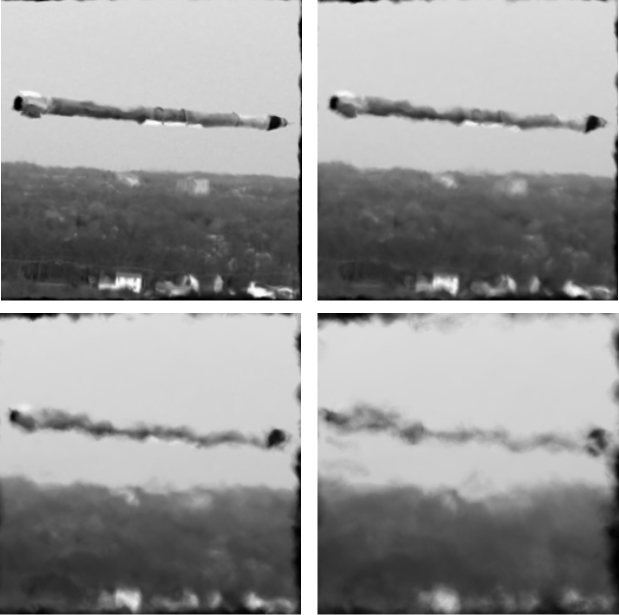
_______________________
The WONAT++ library includes unique mathematical methods and computational techniques developed by Optonicus’ team, which allows comprehensive numerical analysis of atmospheric optical systems in realistic operating conditions. The library has many applications including:
- Active and passive imaging
- Adaptive optics
- Beam combining
- Beam shaping
- Laser communication
- Laser target tracking
- Remote sensing
- Target designation
- Target hit-spot sensing
- Video information fusion

High-speed wave-optics simulations based on GPU/CUDA technology
Predictive numerical analysis of atmospheric optical systems is commonly performed using the Monte-Carlo technique. The Monte-Carlo approach requires numerical integration of the wave propagation equations in an optically inhomogeneous medium such as the atmosphere to be repeated hundreds of times and results in extremely time-consuming computations.
To address this challenge, II-VI's research team extended its numerical simulation capabilities by adopting the GPU/CUDA-based computational hardware and software. The WONAT++ library enhanced by the GPU/CUDA technology allows from 10x to 100x acceleration of routine wave-optics simulations.
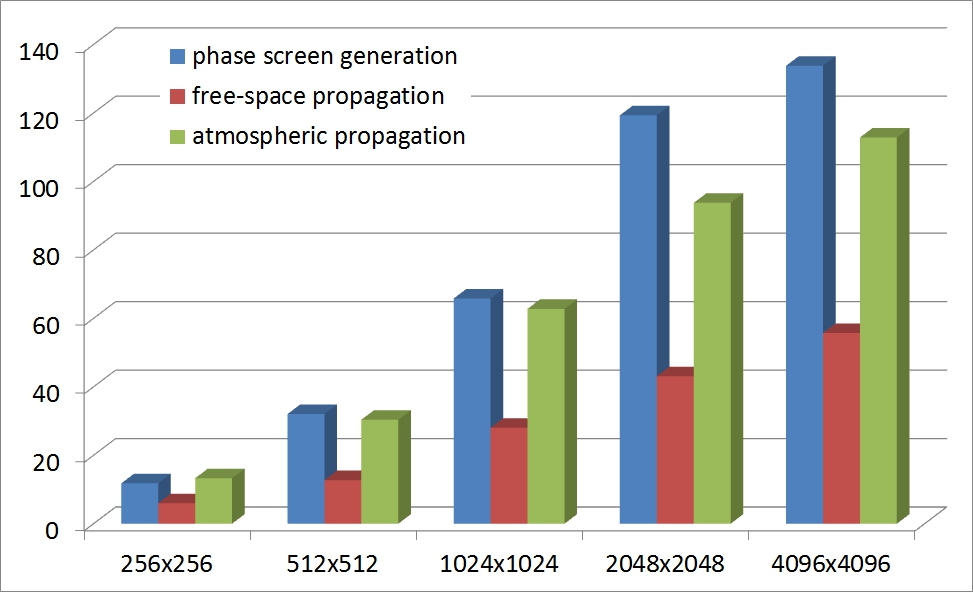

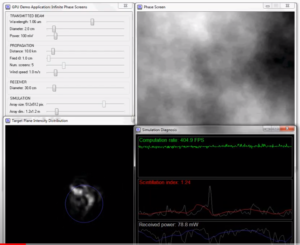
Computer generation of infinitely long atmospheric phase screens with predefined and varied statistical characteristics
This novel technique offers truly unique capabilities for computer analysis of atmospheric optical systems operating from moving platforms, as well as considers engagements with targets moving over long distances. The movie on the left illustrates the generation of infinitely long phase screens with Kolmogorov atmospheric power spectrum model with fixed statistical characteristics (top-right corner), as well as the propagation of a Gaussian laser beam through atmospheric turbulence modeled by five such screens (bottom-left corner). The computation rate (here around 400 Hz for a 512x512 grid resolution), the scintillation index, and the power measured at the receiver are displayed at the bottom-right of the movie.
To learn more, see A. M. Vorontsov, P. V. Paramonov, M. T. Valley, and M. A. Vorontsov, “Generation of infinitely long phase screens for modeling of optical wave propagation in atmospheric turbulence,” Waves in Random and Complex Media, vol. 18, no. 1, pp. 91–108, 2008.
Analysis of long-range atmospheric turbulence effects on optical system performance
Successful development of long-range (>30 km) atmospheric optical systems depends heavily on accurate prediction and performance assessment in various atmospheric conditions and engagement scenarios. The turbulence theory upon which current predictive models are based has only been verified for short propagation distances of several kilometers. Extrapolation of these models to assess performance of long-range systems can result in significant errors. In particular, with recent long-range atmospheric propagation experiments there was a substantial deviation between the data received, and predictions based on classical atmospheric turbulence models [1]. These deviations are most likely caused by the presence of 3D refractive index coherent structures with long correlation lengths that are not accounted for in existing theory and numerical models. The II-VI team has developed innovative mathematical tools for computer generation of 3D (volume) random refractive index fields having arbitrarily long spatial correlation properties. For the first time, this new simulation capability enables high-accuracy analysis of long-range (deep) turbulence effects on optical systems.
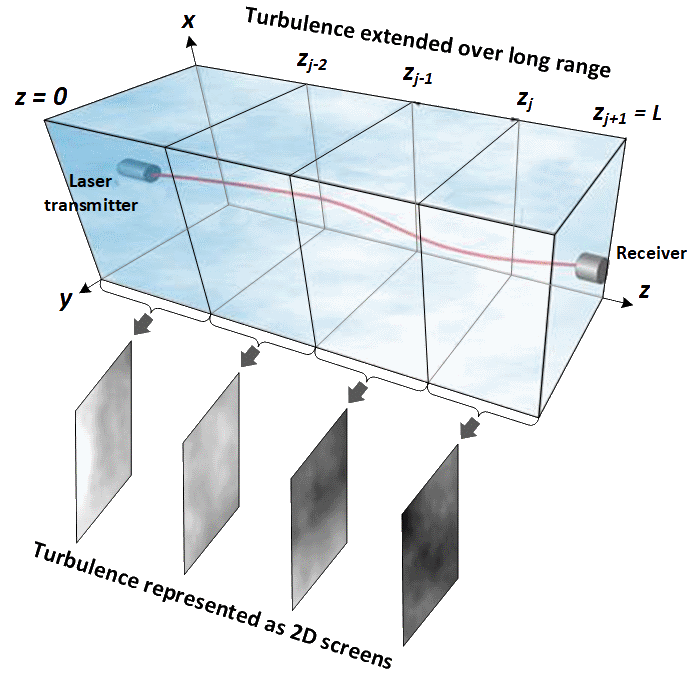

In the conventional technique based on the “split”-operator method, the turbulence-induced refractive index inhomogeneities are represented by a set of infinitely narrow (2D) phase distorting layers (phase screens) [2].These 2D phase screens are statistically independent (delta-correlated) along optical wave propagation direction. This commonly used model cannot be applied for computer analysis of long-range and deep turbulence effects associated with presence of large-scale (thick) refractive index layers with long correlation lengths. For the same reason the conventional “thin” (2D) phase screen approach does not permit analysis of optical systems whose performance depends on variation in optical path difference (piston phase) along the propagation path. Among these systems are coherent imaging ladars, optical vibrometers and interferometers.
Contrary to the conventional approach, in the 3D-turbulence computer simulation technique developed by II-VI, the turbulence-induced refractive index inhomogeneities are represented by a set of large-scale phase distorting slabs extended over long distance, as shown in the picture on the left. In each 3D turbulent slab statistical properties of the refractive index correlation are preserved inside the entire 3D volume. The turbulent slabs can be extended up to a few kilometers or even longer.
1. M. A. Vorontsov, G. W. Carhart, V. S. Rao Gudimetla, T. Weyrauch, E. Stevenson, S. L. Lachinova, L. A. Beresnev, J. Liu, K. Rehder, and J. F. Riker, “Characterization of atmospheric turbulence effects over 149 km propagation path using multi-wavelength laser beacons,” Proceedings of the 2010 AMOS Conference, p. E18, 2010.
2. M. C. Roggemann and B. Welsh, Imaging Through Turbulence, CRC Press, 1996.
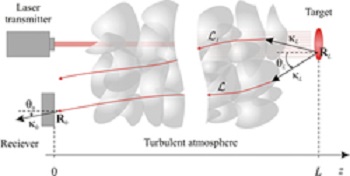

Target-in-the-loop (TIL) beam propagation and speckle effects: modeling and performance analysis
The innovative TIL laser beam propagation mathematical and computational models based on the brightness function method offers up to an order of magnitude decrease in the computational time required for analysis of directed energy, active imaging and laser designation systems operating with extended (speckle) targets. The developed computational technique allows accurate analysis of laser beam propagation with various spatial and temporal coherence characteristics, scattering off extended target of different shapes and surface roughness and accounts for back scattering speckle-field propagation through atmospheric channels.
To learn more, see M. A. Vorontsov and V. Kolosov, “Target-in-the-loop beam control: Basic considerations for analysis and wavefront sensing,” J. Opt. Soc. Am. A, vol. 22, no. 1, pp. 126–141, 2005, and V. V. Dudorov, M. A. Vorontsov, and V. V. Kolosov, “Speckle-field propagation in “frozen” turbulence: brightness function approach,” J. Opt. Soc. Am. A, vol. 23, no. 8, pp. 1924–1936, 2006.
Anisoplanatic imaging through atmospheric turbulence: brightness function approach
This new numerical technique allows computationally efficient numerical analysis of incoherent (white light) wide field of view imaging systems operating in turbulent atmosphere. The images on the left represent examples of numerical simulation of the performance of imaging sensor of the tracker system in different turbulence conditions (turbulence strength increases from top-left to bottom-right picture).
To learn more, see S. L. Lachinova, M. A. Vorontsov, V. V. Dudorov, V. V. Kolosov, and M. T. Valley, “Anisoplanatic imaging through atmospheric turbulence: Brightness function approach,” Proc. SPIE, vol. 6708, p. 67080E, 2007.


